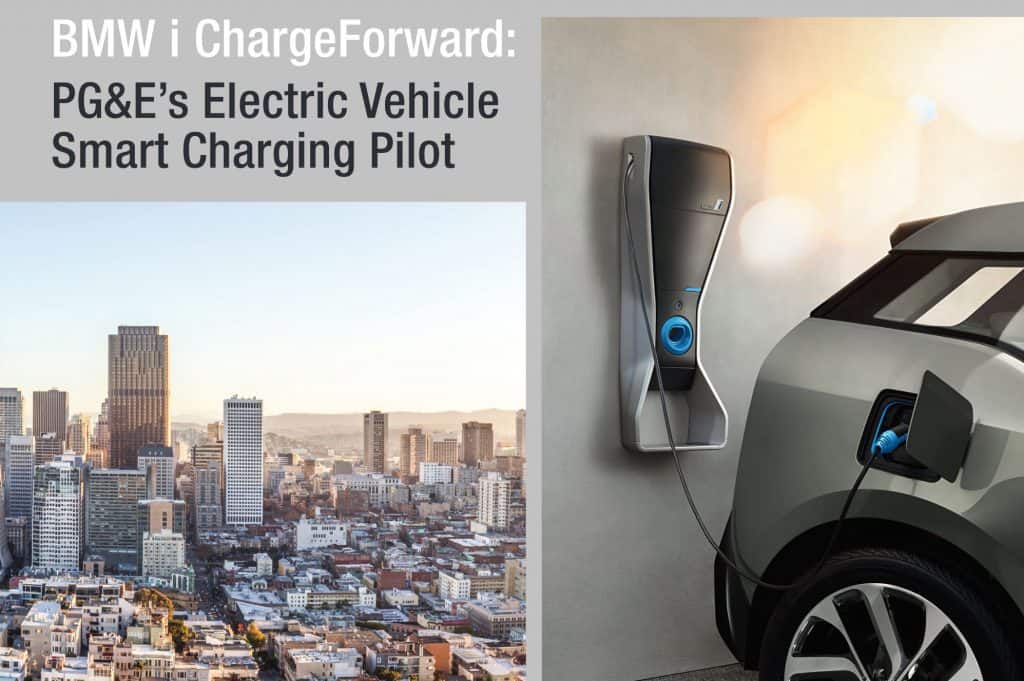
PG&E and the BMW Group are kicking off phase three of their ChargeForward program. This new phase will expand the program to all BMW EV drivers in Northern and Central California who are PG&E residential, electric customers. Designed for a larger group of BMW EV drivers—about 3,000 EV drivers compared to 100 and 400 in phase one and two—phase three of the pilot will further explore how incentivizing drivers to shift their EV charging times can help meet the needs of the electric grid and use excess renewable energy available during the day. As part of this, PG&E will work with BMW to send signals to participants encouraging them to charge at times that support the grid.
Enrollment in phase three of the ChargeForward program kicks off today, with the program launching in mid-April and running through March 2023.
In the future, PG&E and the BMW Group believe that vehicles could play a larger role in supporting the grid as new vehicle technologies are developed. Future EVs may have the capability to discharge the vehicle battery to support the grid, expanding the capabilities beyond smart charging and supporting customers and the grid during emergencies. To support this, PG&E and the BMW Group will collaborate in a lab setting to explore this potential by testing vehicle-to-grid functionalities. These efforts could support bill savings for customers driving EVs and include testing the use of EV batteries for backup generation and other grid services.
What is Smart Charging?
Through smart charging, EVs act as a flexible grid resource to support the overall reliability of the electric grid. Smart charging focuses on moving EV charging away from times when electricity is in high demand and toward times when there is less demand and also more renewable energy on the grid such as mid-day.
By responding to requests to move their EV charging times, drivers will support the electric grid and take advantage of clean, renewable energy. Additionally, using EVs as a flexible grid resource could ultimately lead to cost savings associated with operating and maintaining the grid as well as for customers owning an EV.
“Our sustainability vision at the BMW Group aims to bring sustainability principles to all aspects of the customer experience—including the energy our vehicles use. ChargeForward demonstrates how our company’s digital technology can help customers use more renewable energy and reduce their energy costs,” said Adam Langton, Energy Services Manager, Connected eMobility, BMW of North America. “ChargeForward is part of the BMW Group’s commitment to provide our customers with charging solutions that are convenient, reliable and sustainable.”
“The more than 320,000 electric vehicles plugging into PG&E’s electric grid offer a unique resource that contributes to building our clean energy future in California. As EV adoption continues to grow, the potential for these clean vehicles as a flexible grid resource becomes more significant. Our ongoing collaboration with BMW has allowed us to explore and demonstrate future possibilities of scaling the smart charging capabilities of this growing resource to support the electric grid,” said Quinn Nakayama, Director of Integrated Grid Planning and Innovation at PG&E.
BMW ChargeForward Phase Three Program Participation
BMW expects approximately 3,000 BMW EV drivers in PG&E’s service area to participate in this phase of the pilot. Interested consumers can complete an application at www.bmwchargeforward.com starting today. BMW hopes to expand the availability of the program to MINI electrified customers in the near future.
Through BMW ConnectedDrive—which enables connectivity among cars, drivers and their surroundings—and a customized BMW ChargeForward smartphone app, participating BMW drivers will be able to opt-out of any smart charging request, based on their driving and personal preferences. When a customer allows their vehicle to be smart charged, the vehicle charging will be shifted to meet the needs of the electric grid.
Participating BMW EV drivers earn incentives for smart charging including $150 at sign-up and up to an additional $250 per year by following ChargeForward recommendations. The total amount earned over the two years depends upon individual participation in charging events. During the spring and fall months, program participants could earn incentives that offset the entire cost of charging their vehicle, charging 750 miles per month with clean electricity at no cost due to the ChargeForward incentives and plugging into the grid when renewable energy is highly available.
BMW and PG&E ChargeForward Partnership
ChargeForward launched in 2015 to test the ability of EVs to support the electric grid and provide benefits to customers through vehicle-grid-integration applications that enable smart charging and demand response. Optimizing charging with renewable energy was the focus of the second phase. Initial tests of renewable optimizations showed participants averaged more than 55% of renewable energy charging, more than double the national average at the time.
Highlights from the ChargeForward phase two pilot include:
- Over 1 million miles were powered by 100% renewable energy charging during a one-year period;
- Smart charging EVs can reduce greenhouse-gas emissions by an additional 32% on average in Northern California, according to research from the University of California Berkeley;
- Smart charging, when combined with broad access to workplace charging infrastructure, enables plug-in electric vehicles to more than double their renewable energy usage; and
- A smart-charging plug-in hybrid can integrate more renewable energy than a normal-charging all-battery electric vehicle, despite the smaller battery size.